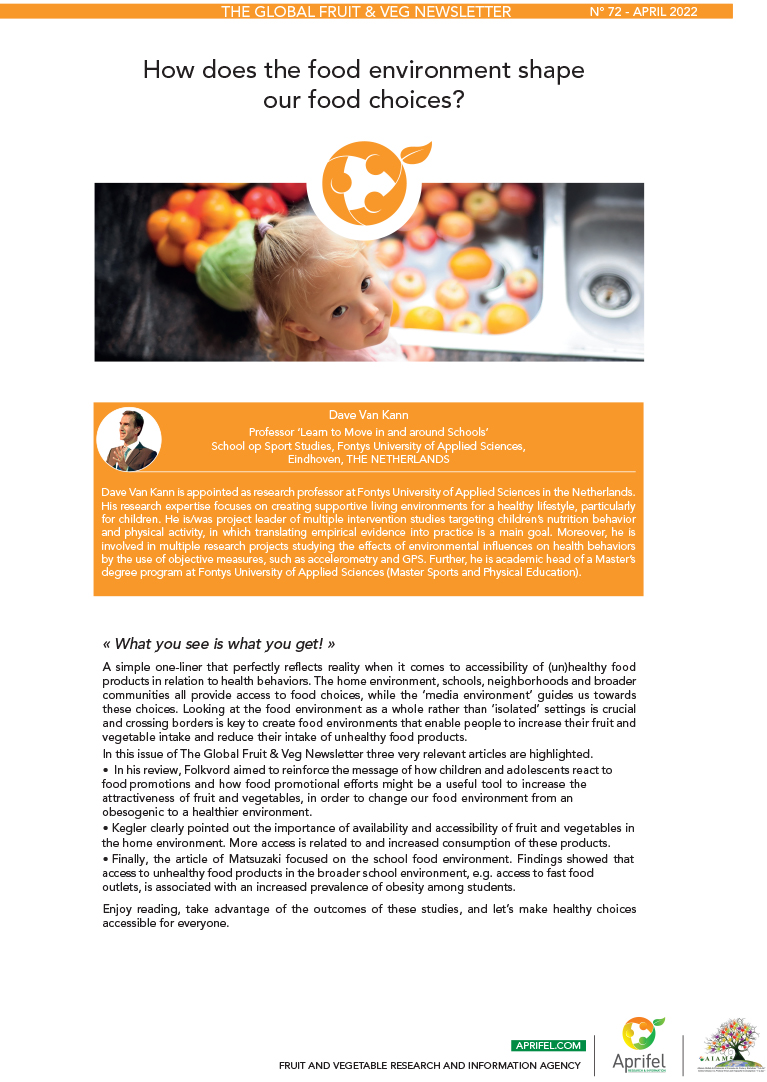Food environment near school and body weight by demographic and socioeconomic subgroups

With more than 340 million children and adolescents being overweight or obese in 2016 (WHO, 2021), childhood obesity has become a public health crisis around the world. Children suffering from obesity are more likely to develop a variety of health problems as adults such as cardiovascular disease, insulin resistance, musculoskeletal disorders, some cancers, disability, and mental disorders. Numerous studies highlight the role of the food environments near schools in shaping children’s dietary behaviors and body weight. A previous systematic review reported associations between the presence of fast-food outlets near schools and childhood obesity, but the associations by race/ethnicity, gender and income level have not been previously synthetised (Williams, 2014).
Therefore, this review evaluated the existing evidence on the associations between the food environments (examining the presence of fast-food outlets, convenience stores, supermarkets, and grocery stores) near schools and obesity by demographic and socioeconomic subgroups.
Fast food outlets near schools were associated with obesity among Latino students and in all school grades
Fast-food outlets were mostly examined with twelve studies reporting results on their availability near schools and weight status.
There was consistent evidence of positive associations between greater availability of fast-food outlets near schools and obesity among Latino students with three studies reporting clear evidence (Currie, 2010; Grier, 2013; Sanchez, 2012). For other racial/ethnic groups (African American, White, and Asian), the magnitudes, directions of the effects, and the strengths of evidence were less consistent. For example, among White students, two studies showed weak to moderate of evidence for positive association (Currie, 2010; Sanchez, 2012) while one study showed a negative one between distance to fast food outlets and weight status (Grier, 2013).
Positive associations were also consistent between obesogenic food environments near schools and weight status across students in all school grades, though the strengths of evidence varied. Potentially large effects could be seen for children in younger grades.
In the gender-stratified analysis, there was some variation in the evidence of association between fast-food outlets near schools and weight status. Two studies from California found positive association for both boys and girls (Currie, 2010; Sanchez, 2012), one study from Taiwan saw stronger evidence for boys while a study from Korea showed stronger evidence for girls (Park, 2013; Chiang, 2011).
When stratified by socioeconomic status, some evidence suggested greater positive associations between food environments near schools and obesity among children and school-neighborhoods at lower socioeconomic status.
Convenience stores near schools were associated with obesity among Latino and African American students
Eight studies investigated convenience store availability near schools and weight status. Three studies reported generally positive associations between convenience stores and obesity among Latino and African American students (Langellier, 2012; Powell, 2007; Sanchez, 2012), while mixed associations were noted among White and Asian children. Concerning associations by school grades, weak evidence reported that greater availability of convenience stores within 0.5 mile radius of a school was associated with higher prevalence of overweight/obesity among 5th and 7th grade students, while no clear evidence of association was observed among 9th grade students (Powell, 2007).
Supermarkets and grocery stores were less commonly studied
A smaller set of studies examined influences of grocery stores (n=3) (Park, 2013; Powell, 2007; Harrison, 2011) and supermarkets (n=3) (Powell, 2007; Leatherdale, 2011; Williams, 2015). According to this review, there were negative associations between grocery stores/supermarkets and weight status in some subgroups. However, much fewer studies examined such associations, thus, the evidence for associations on these specific food outlets in subgroups remains unclear.
However, longitudinal studies are needed to better understand causal mechanisms of the effects of food environment near schools on weight status within each subgroup.
Based on : Matsuzaki M, et al. Food environment near schools and body weight-A systematic review of associations by race/ethnicity, gender, grade, and socio-economic factors. Obes Rev. 2020;21(4):e12997
- Fast food outlets were most commonly examined.
- Positive associations were seen between fast food outlets near schools and obesity with consistent evidence among Latino children as well as children in all grade levels, with potentially large effects for children in younger grades.
- Additional studies are needed to evaluate whether the presence of supermarkets, convenience and grocery stores near school may influence childhood obesity.

